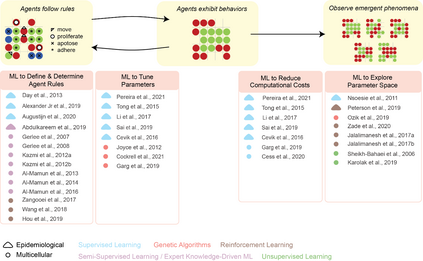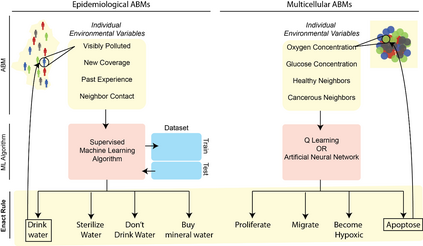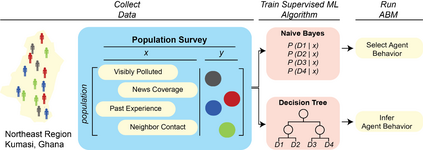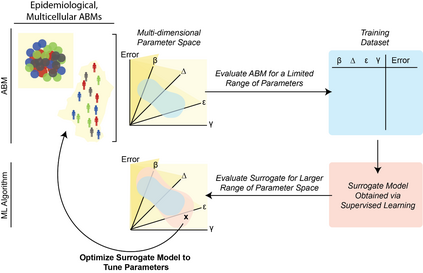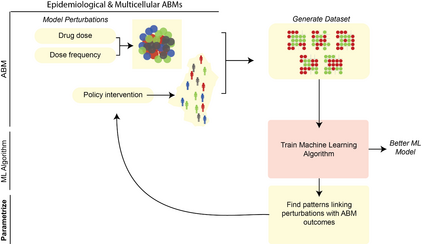Agent-based modeling (ABM) is a well-established paradigm for simulating complex systems via interactions between constituent entities. Machine learning (ML) refers to approaches whereby statistical algorithms 'learn' from data on their own, without imposing a priori theories of system behavior. Biological systems -- from molecules, to cells, to entire organisms -- consist of vast numbers of entities, governed by complex webs of interactions that span many spatiotemporal scales and exhibit nonlinearity, stochasticity and intricate coupling between entities. The macroscopic properties and collective dynamics of such systems are difficult to capture via continuum modelling and mean-field formalisms. ABM takes a 'bottom-up' approach that obviates these difficulties by enabling one to easily propose and test a set of well-defined 'rules' to be applied to the individual entities (agents) in a system. Evaluating a system and propagating its state over discrete time-steps effectively simulates the system, allowing observables to be computed and system properties to be analyzed. Because the rules that govern an ABM can be difficult to abstract and formulate from experimental data, there is an opportunity to use ML to help infer optimal, system-specific ABM rules. Once such rule-sets are devised, ABM calculations can generate a wealth of data, and ML can be applied there too -- e.g., to probe statistical measures that meaningfully describe a system's stochastic properties. As an example of synergy in the other direction (from ABM to ML), ABM simulations can generate realistic datasets for training ML algorithms (e.g., for regularization, to mitigate overfitting). In these ways, one can envision various synergistic ABM$\rightleftharpoons$ML loops. This review summarizes how ABM and ML have been integrated in contexts that span spatial scales from the cellular to population-level scale epidemiology.
翻译:以代理为基础的模型( ABM) 是用来通过组成实体之间的相互作用模拟复杂系统的完善范例。 机器学习( ML) 指的是统计算法从自身数据中“ 精液” 取自其自身的数据, 而不强加系统行为的先验理论。 生物系统 -- -- 从分子、 细胞到整个生物体 -- -- 由大量实体组成, 由复杂的互动网络管理, 由跨越许多空间尺度的复杂互动网络管理, 显示实体之间的非直线性、 随机性和错综复杂的组合。 这种系统的宏观特性和集体动态很难通过连续建模和平均格式来捕捉取。 ABML采取“ 自下而上而上”的方法, 避免这些困难, 使一个人能够轻松地提议和测试一套定义明确的“规则 ”, 从分子到整个系统中的单个实体( 代理人), 评估一个系统, 传播其状态, 通过离散的时间步, 有效地模拟这个系统, 允许观测结果, 和系统特性分析。 由于管理反弹道导弹的规则可能从抽象系统到实验性系统,, 从实验性地, 变现一个系统,, 货币变货币变货币规则 。

